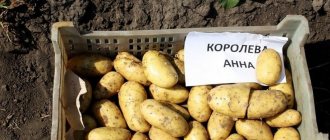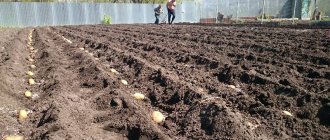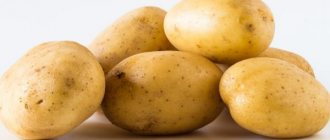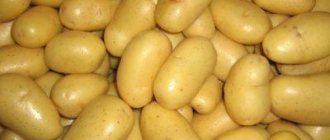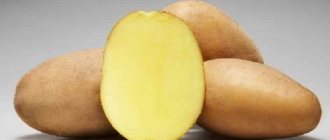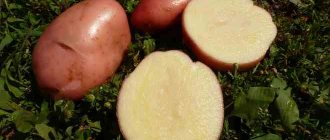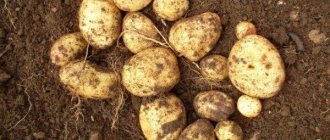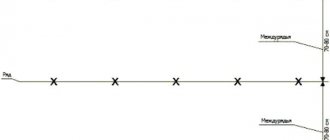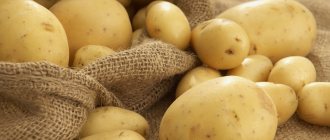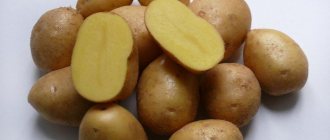Characteristics of the Ragneda potato variety
Above is a photo of the Ragneda potato variety, which matches its external description. The crop has a medium-late ripening period; it sprouts 15 days after planting the planting material. Root crops reach biological ripeness in 4 months. After 85 days, the tubers are at the stage of conditional ripeness and become suitable for consumption. Young potatoes taste no different from fully ripened ones. It has a more watery consistency, thin, unformed peel. Unripe tubers contain a low concentration of starch, so the fruits do not become soft during the cooking process.
Ragneda potatoes are adapted to temperate climates and are frost-resistant varieties. If the sprouts are damaged by returning spring frosts, the variety quickly recovers; freezing does not affect the yield level or ripening time. Ragneda potato is a drought-resistant plant; the growing season does not slow down due to moisture deficiency. The plant does not tolerate waterlogging of the soil well; excess water can cause rotting of the tubers and the lower part of the stems.
General characteristics of the variety:
- The tall bush is formed by 5 stems, reaching up to 85 cm. The stems are erect, thick, and light green. With excess moisture, the tops lose their elasticity and break easily.
- The foliage grows densely, the shape of the leaf blade is round, tapering towards the top. The surface is corrugated, with a small edge, with convex veins, the edges are smooth.
- The flowers are white with an orange core, collected in panicle-shaped inflorescences.
- The root crops are round, slightly elongated, of medium size, weighing 70-120 g. The root system forms up to 14 fruits, 90% of the potatoes in the bush are approximately the same shape. The arrangement of the tubers is compact, the root does not grow to the side.
- The peel is thin, durable, yellow in color with a smooth surface and a few eyes.
- The pulp is dense, juicy, light beige, the potatoes do not darken after peeling and at the cut site.
Thanks to its smooth, medium-sized fruits, the Ragneda variety is convenient for mechanized harvesting. It is grown over large areas for commercial purposes and the food industry. In garden plots, the variety is considered a favorite due to its unpretentiousness in care, taste and stable yield.
Important! Ragneda potato roots that have reached biological ripeness can remain in the ground for more than 3 weeks, maintaining their taste and presentation.
Diseases and harmful insects
The Ragneda potato variety is resistant to almost all diseases, as evidenced by its characteristics. Strong immunity to golden nematode, potato cancer and late blight. Also tolerates wrinkled and banded mosaics. Resistant, but not very resistant to blackleg, scab, anthracnose, dry rot and various viruses.
The Colorado potato beetle is the most popular pest. To overcome it, special chemicals are used. Loosening the soil and clearing the area of excess grass helps prevent wireworms. Special chemicals are used against aphids, mole crickets and cutworms.
Pros and cons of the Ragneda variety
Belarusian varieties have long been in deserved demand among farmers and consumers. Ragneda potatoes are cultivated almost throughout the entire territory of Russia, except for the risky farming zone. The variety has earned such attention due to a number of advantages:
- adapted to the temperate climate zone;
- frost-resistant, quickly replaces damaged shoots;
- goes without watering for a long time;
- fruit size is suitable for mechanized harvesting;
- seeds are not prone to degeneration;
- stable fruiting;
- high productivity;
- strong immunity;
- undemanding to soil composition and agricultural technology;
- stored for more than 8 months, waste of the total volume – 12%;
- withstands mechanical stress during transportation;
- has good taste and presentation;
- contains optimal starch index and concentration of active substances;
- the pulp retains its color after heat treatment.
The absence of shortcomings in the characteristics of the Ragneda potato variety is confirmed by reviews from vegetable growers. The only conditional disadvantage of the crop is the tendency to develop rhizoctonia in cold, damp weather with severe waterlogging of the soil.
Advantages and disadvantages
| Advantages | Flaws |
| High yield | Requires low temperatures during storage, otherwise it germinates quickly |
| Resistance to late blight, potato blight and many other diseases | If care rules are not followed and bad weather conditions may grow small |
| Good taste and boilability of potatoes | |
| Resistance to damage and good preservation | |
| The variety is not picky about the choice of soil | |
| High germination energy and uniform appearance of all sprouts |
Planting and caring for Ragneda potatoes
Ragneda potatoes are planted in the second half of May, the timing is coordinated with the climate. If the soil has warmed up to +160 C, planting work can begin.
Selection and preparation of a landing site
Ragneda potatoes are unpretentious to soil composition and produce a stable harvest on any soil, except lowlands and wetlands. The fruiting rate increases if the composition is fertile; preference is given to light sandy loam soil.
Attention! For photosynthesis, the Ragneda variety needs a sufficient amount of ultraviolet radiation; in the shade, the growing season slows down and the fruits become smaller.
The site has been prepared since the fall. Remove the remains of old tops and weed roots. They dig up the soil and add organic matter. In the spring, 14 days before planting the seeds, the area is dug up again and saltpeter is scattered.
Preparation of planting material
To speed up the growing season of the plant, the mid-late variety Ragneda is bred with sprouted seeds. You can purchase them or prepare them yourself. Potatoes are selected in the fall after harvest or in the spring. Take medium-sized seeds, weighing 60 g.
Planting material, prepared in boxes in the fall, is taken out for germination. In the spring, you can select the seeds and put them in a container or spread them in a thin layer on a flat surface. Seeds are prepared approximately at the end of March. Ragneda potatoes are sprouted in good light and a temperature of +80 C. Sprouts for planting should grow no more than 2.5 cm.
Landing rules
Ragneda potatoes are planted in single holes or furrows, the planting pattern is the same. The depth of the hole is 16 cm, the row spacing is 50 cm, the distance between the bushes is 35 cm. Two tubers are placed in one planting hole at a distance of 7 cm. The top is covered with a mixture of peat and ash in equal proportions, then with soil.
Watering and fertilizing
With the condition of single precipitation per month, Ragned potatoes are not additionally watered. If the summer is dry, one intensive watering is enough after 3 weeks after flowering. Fertilizing is applied in the spring a month after planting the seeds, fertilized with phosphate, potassium agents, and urea. Nitrogen-containing fertilizers are applied at the time of flowering.
Loosening and weeding
Ragneda potatoes will produce young shoots 15 days after planting the seeds. When the crop has grown enough to define rows, the first weeding is carried out. When the variety grows to 15 cm, repeated loosening is necessary to remove weeds and ensure unhindered access of oxygen to the root system. Cut weeds and roots are removed from the garden bed.
Hilling
Ragneda potatoes are hilled up when the tops grow to 25 cm. If planting was done in holes, soil is poured on all sides, up to the top leaves. When placing seeds in furrows, make a continuous mound on both sides in the form of a ridge. After 2.5 weeks the procedure is repeated:
- the embankment is trimmed;
- loosen the top layer;
- remove remaining weeds.
Potatoes Rogneda - description
The originator of the variety is the Scientific and Production Center of the National Academy of Sciences of the Republic of Belarus. Over the course of several years, Rogneda potatoes have become widespread not only in Belarus, but also in the Russian Federation and Ukraine.
Characteristics and features of the variety
Rogneda is part of the group of mid-late varieties, the average ripening period is from 95 to 110 days, but it all depends on climatic conditions and agricultural technology. The bushes are tall, fairly spreading, with medium foliage. The leaves are slightly wavy and the color varies from light to dark green. The variety is characterized by intensive growth of tops. The flowers are not large.
The tubers are smooth, beautiful, oval in shape. Potato weight is from 78-80 to 120 grams. The peel is dense, yellowish in color. There are a few small eyes located on the surface.
The color of the pulp is creamy, the structure is dense. Rogneda is valued for its excellent taste and the ability to use potatoes for preparing various dishes. When cooked, it softens well, but at the same time retains all its taste. The starch content is as follows: from 12 to 16-18.4%. This variety is great for mashing, making soups, casseroles, and boiling jacket potatoes.
It is valued for the attractive appearance of the tubers, the ability to be transported, and excellent keeping quality.
Productivity
What results can you get by growing Rogneda potatoes? If traditional agricultural techniques are followed, the yield ranges from 190 to 350 centners of potatoes per hectare of land. Higher results were also recorded - up to 430 centners per hectare.
That is, the variety is productive, but you should not forget about the correct selection and preparation of the site for cultivation, as well as careful care.
Advantages and disadvantages of the variety
The Rogneda variety is popular, quite well known, and all this is due to its advantages:
- Excellent taste of root vegetables.
- High marketability of tubers (which is especially suitable for those who grow potatoes for sale).
- Good keeping quality. Up to 97% of the crop remains rotten until spring without any damage.
- Good yield.
- Unpretentiousness (there are no special techniques in agricultural technology, everything is quite traditional).
- Resistance to a number of diseases and pests (the Rogneda variety is especially noted for its resistance to cyst nematodes, potato cancer, as well as stripe and viral mosaics).
- The tubers contain carotene, which gives the pulp a yellowish-cream color.
- The variety is not picky about soil and grows well in various regions of Russia.
Among the advantages, it is necessary to note the resistance of the tubers to mechanical damage (due to the dense skin), as well as the plant’s resistance to high temperatures.
The Rogneda variety has practically no “cons”, with the exception of the possible appearance on the bush, along with large ones, of small tubers. But most often this occurs when agricultural practices are violated, as well as during bad weather conditions. The variety reacts normally to the vagaries of the weather and produces a good harvest even in an unfavorable season. But in such years they harvest more small potatoes.
Diseases and pests
Over the past few years, the spread of the Y virus has been a problem for farms and small plots. The infection can completely destroy plantings, Ragneda potatoes were no exception. The pathogen is carried by aphids during hot, dry summers. The disease manifests itself as necrosis of the entire bush along with the root system. At the end of May, the plant is treated with insecticides to destroy the vector and larvae of the Colorado potato beetle, which parasitizes nightshades.
The fungal infection rhizoctoniasis manifests itself only under favorable conditions: low temperature and high humidity. The disease is identified by black spots on the leaves and the bottom of the tops. The infection is eliminated using Planriz, Baktofit, and crop rotation.
Features of growing the variety
Everyone wants to get good harvests of “second bread”, but for this you will have to work hard. When growing the Rogneda variety, due to its resistance to disease, fewer preventive treatments will be required, but the basic rules of agricultural technology must be followed.
Preparing the site and seed material
Potato beds should be located in a sunny and open place. The best results are obtained by planting on light and medium soils; on heavy soils, potatoes grow poorly and often rot. They try to maintain crop rotation, returning potatoes to their original place no earlier than after 3-4 years. If this is not possible, it is necessary to cultivate the soil by sowing green manure plants in the fall.
ON A NOTE! Potatoes can be grown after any vegetables. The exception is plants of the nightshade family.
In the fall, the site is dug up and the necessary fertilizers are applied. Organic matter, compost, and wood ash are suitable.
In the spring, the ridges are dug up again to a shallower depth, complex fertilizer or, if available, rotted manure is applied (about 5 kg per 1 m2). The soil surface is harrowed and grooves or ridges are cut.
Potatoes are selected for planting in the fall, so that in the spring the prepared tubers can be brought into the room for germination in advance. This is usually done 25-30 days before the intended planting of potatoes on the ridges.
The tubers are laid out in boxes or boxes in a room where there is diffuse lighting. The temperature should be approximately +8ºC, while the root vegetables are periodically turned over. Over time, sprouts will appear on the tubers, so you need to turn them over carefully so as not to break them.
Planting potatoes
The landing time is determined by the weather:
You may be interested in: Dates for planting potatoes in 2021 for central Russia and the Moscow region Dates for planting potatoes in May-June 2021 according to the lunar planting calendar Favorable days for planting potatoes in 2021 according to the lunar calendar
- the soil temperature should not be lower than +8ºC…+10ºC;
- The leaves on the birch tree should be blooming.
Planting is carried out taking into account the type of soil: in holes, furrows, ridges, maintaining the distance between plants and between rows.
IMPORTANT! When planting the Rogneda variety, you need to take into account that its bushes are spreading, the tubers lie widely in the ground, so you need to leave a distance between plants of at least 35 cm.
Many gardeners strive to compact plantings by planting tubers frequently. But this leads to potato shredding and reduced yield. Conversely, following the planting scheme for such varieties will give a significant increase in yield.
Potato care
After planting the potatoes, the bed remains empty for some time. Shoots appear in 10-14 days, but weeds begin to fill the area already on 4-5 days. Therefore, it is necessary to very carefully loosen with a rake in order to remove weeds, but not damage the potatoes.
Experienced gardeners note that the absence of weeds in a potato field, especially in the first period, when the sprouts are just sprouting, is the key to a high yield in the fall.
Watered infrequently, this variety is resistant to hot weather and drought. Typically, watering is needed during the period of budding and flowering of potatoes. It is also advisable to water the potatoes before hilling (if there has been no rainfall for a long time).
They spud Rogneda two or three times:
- the first time when the sprouts reach a height of 10-12 cm;
- the second time - when the tops are closed in the row (usually about two weeks pass after the first hilling).
Before the second hilling, it is recommended to feed the potatoes with nitrophoska, then water the plants. The fertilizer rate is 10 grams of dry matter per bush.
Potatoes are harvested around mid-September, again, based on the timing of planting, the ripening of tubers, and the condition of the plants themselves.
Tubers that are fully ripe (state of technical ripeness) are suitable for storage, while tubers can be dug up for food at the end of summer even during the period of conditional ripeness (having a thin flaky peel).
ON A NOTE! To ensure complete and better ripening of the tubers and improve their shelf life during storage, it is recommended to trim the potato tops two weeks in advance.
When harvesting, try not to damage the tubers; be sure to dry them before storing them in storage. It is necessary to sort the potatoes in the fall, selecting the best tubers for seeds.
Diseases and pests
Rogneda potatoes are resistant to diseases and major pests. As a preventive measure against late blight (after all, it is a mid-late variety), you can use treatment with copper-containing preparations:
- first spraying in the budding phase;
- the second – 14 days after the first;
- third - if spots suddenly appear on the leaves.
Preventive spraying with the following infusions helps against the Colorado potato beetle, a dangerous and very insidious pest:
- wormwood and burdock leaves (take 0.5 kg of herbs for three liters of water);
- onion peels (100 grams per three liters of water);
- bitter red pepper (50 grams per three liters of water).
Potato bushes are treated several times a season. The first spraying is carried out simultaneously with the first hilling, when the sprouts are about 10-12 cm high.
Harvesting and storage
Mid-late Ragneda potatoes ripen approximately at the end of August. If the crop is not harvested in a timely manner, the root crops remain unchanged in the soil, in this form they can lie until frost sets in. As a rule, harvesting is carried out promptly in early September.
Recommendations for harvesting:
- Potatoes are not left in the sun for a long time - ultraviolet radiation triggers the synthesis of solanine (a substance toxic to humans), and green fragments appear on the surface of the root crop.
- The tubers are removed to a shaded place.
- Wash and dry well (for further sale).
Potatoes are usually not washed for home storage. It is enough to spread it in a thin layer, dry it, then collect it in a container for storage.
Ragneda potatoes are stored in boxes or canvas bags, if the room allows, in bulk.
Important! Requirements for storage space: no light, temperature – no higher than +50C, air humidity – 80%.
Ragneda potatoes retain their taste and appearance until the end of May.
Origin story
About 10 years ago, specialist breeders from the Scientific and Production Center of the National Academy of Sciences of Belarus for Potato and Fruit and Vegetable Growing developed a new potato variety called Ragneda by crossing the Magician and form 1579-14.
In 2011, this potato was already registered in the State Register of Russia with a recommendation for cultivation in the Central and Northwestern districts. But thanks to many interesting characteristics, the popularity of this potato variety is gaining momentum, and it is grown not only in Belarus and in the above-mentioned regions, but also in many other regions of Russia and even in Ukraine. The easiest way to purchase seed material of this variety is through the Institute of Potato Growing, located near Minsk in the village of Samokhvalovichi.
Description and characteristics
Ragneda potatoes belong to medium-late varieties in terms of ripening time - in order for the tubers to ripen well, it is necessary that 95 to 110 days pass from the moment the first shoots appear. Of course, to grow such potatoes, you will need more work and patience than for early varieties, but the taste and yield will pay off all your efforts.
Potato bushes grow tall, with an abundance of leaves, and do not have a particular tendency to spread out to the sides; however, hilling will have a beneficial effect on increasing productivity. The leaves are medium-sized, smooth, almost without wavy edges, and have a color from light green to green.
The Ragneda variety is gaining great popularity, primarily due to its high yield rates.
And if you create good conditions for growth and development, you can get up to 430 c/ha. For a gardener, especially a beginner, it is more interesting to find out how many potato tubers can be harvested from one Ragneda bush. This amount can be 15-20, and this should be taken into account when planting potatoes - tubers should be planted at a slightly greater distance than usual early varieties.
A special feature of the Ragneda potato variety is that the plants adapt very well to different growing conditions and soils, and therefore are interesting for use in different regions and for beginners in gardening.
Root vegetables have the following characteristics:
- The shape of the tubers is oval-round and regular;
- The eyes can be of both shallow and medium depth;
- The peel has a yellow tint and the flesh is creamy white;
- The tubers grow of medium size, the weight of one root crop ranges from 78 to 120 grams;
- The starch content is quite significant and can vary from 12.7 to 18.4%. Due to this, potatoes tend to boil well when cooked.
The percentage of marketable potato fruits among the total harvest ranges from 83 to 96%, depending on weather conditions. Such a large scatter shows that with a lack of moisture and other unfavorable conditions, Ragneda potatoes can produce a significant number of small tubers that are not very suitable for sale.
Potatoes store well, keeping quality is about 97%. But, due to the high germination energy of tubers, friendly sprouts usually begin to actively appear in root crops already in February-March. To prevent this from happening, the temperature in the storage facilities must be strictly kept between 0 and +2°C, which, of course, is not always feasible in ordinary village cellars, especially in the southern regions.
The taste qualities of potatoes of the Ragneda variety are rated as good and excellent. Root vegetables make wonderful mashed potatoes. The variety belongs to the table variety according to its intended purpose.
The value of the variety lies in its fairly high resistance to most common diseases, primarily late blight. Also, the Ragneda variety is well resistant to potato cancer, golden cyst nematode, wrinkled and striped mosaic and leaf curl virus.
Landing
To plant Ragneda potatoes, it is important to choose the optimal timing - at a depth of 10 cm, the soil temperature should be at least +8°C. But in order not to walk around the garden with a thermometer, most experienced gardeners advise focusing on the blooming of birch leaves
The best moment for planting potatoes comes when the birch tree begins to be covered with a barely noticeable green haze of foliage. Delay in planting is also undesirable, since the soil may lose most of the moisture it contains.
Usually, a month before planting, potatoes are germinated in the light, thereby discarding diseased and weak tubers with weak, thread-like sprouts even before planting.
Almost any place for planting the Ragneda variety is suitable, it is only desirable that tomatoes were not grown on it in previous years, since they have the same pests and diseases as potatoes.
It is better to plant more sparsely, leaving at least 15-20 cm between tubers, and 70 to 90 cm between rows. In this case, the bushes will have enough space to form a significant harvest.
Ragneda potatoes are relatively unpretentious to growing conditions, but still some basic care procedures must take place.
Hilling and feeding
It is traditionally believed that it is impossible to grow potatoes without hilling. Indeed, this procedure allows you to obtain much more significant yields, and even when using unconventional methods of growing potatoes (such as under straw), hilling also plays an important role. In the latter case, they simply cover the bushes not with earth, but with straw.
After all, this procedure not only promotes the formation of additional roots on potato bushes, but also preserves soil moisture, limits the growth of weeds, and also enhances air exchange in the upper layers of the soil, where young tubers develop.
Hill up potatoes at least 2 times per season:
- The first time - when the sprouts reach a height of 15-20 cm, covering them almost completely;
- The second time - some time before flowering, without waiting for the bushes to close.
If you use mowed grass with humus for hilling, this will serve as additional feeding for the potato bushes.
It is optimal to combine other fertilizing with watering the potatoes; this is especially important to do during flowering, if there is no natural precipitation during this period
